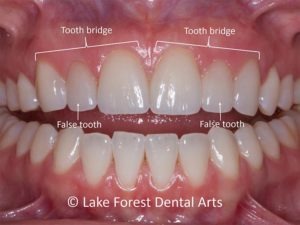
Many people do not know how to clean a dental bridge. Tooth loss is never an ideal circumstance, but when life happens, restorative dentistry can restore a full, functional smile. Thankfully, with the number of tooth replacement methods available, restoring your smile is relatively simple. One of the more common dental restorations is a dental bridgework. Bridgework can replace missing teeth in your smile with artificial teeth, to provide a seamless, natural looking appearance. Yet, while they can restore smiles flawlessly, cleaning underneath one can prove a bit difficult. For those who have recently had one placed, proper cleaning is an important thing to learn and master.
Why a Clean Bridge is Important for Your Health
Cleaning your dental bridge often is key to preventing oral health complications such as tooth decay or gum problems. As with any surface in your mouth, harmful oral bacteria will find their way onto your new dentistry. If not properly cleaned and maintained, oral bacteria could accumulate underneath and around the false tooth leading to periodontal disease. The sore, inflamed, and red gums are a sign of gingivitis. This could lead to extensive infection of the soft supportive tissues of your mouth. This can be harmful for your natural teeth and gum tissue. It could alter how your bridgework fits against the gum. Staying on top of oral hygiene is the best way to ensure your bridge remains healthy and strong for years to come.
Types of Bridges
Proper cleaning technique largely depends on the types of dental bridgework you have. Some people refer to removable partial dentures as a removable bridge. This type of tooth restoration appliance can be removed for easy at home cleanings after meals or at night. These typically are cleaned in the same manner as removable dentures.
Three common varieties of permanent bridges exist, including:
- Traditional bridges: These restorations are most often placed when natural teeth are found on both sides of a missing tooth. Dental crowns are placed on each natural tooth to create a stable hold for the false tooth in between. Traditional bridges are the most common type of bridge and are typically fabricated from beautiful porcelain or porcelain fused to metal.
- Traditional bridge with ovate pontic: This version has a false tooth that extends very tightly up into the gum. There is absolutely no space under the false tooth. Flossing under ovate pontics is discouraged.
- Cantilever bridges are similar to traditional versions but have only one supportive crown abutment on one side of the pontic. Typically, these are only placed on teeth that do not support a large amount of pressure or biting force.
- Maryland bridges are the final type of fixed bridge. It is composed of a pontic supported by metal or porcelain “wings” that are bonded around adjacent teeth.
Dental Bridge Cleaning Techniques and Methods
Cleaning your fixed bridgework can take some getting used to. Some patients may find it difficult to adequately clean underneath the pontic. However, special tools, and practice, can help you clean better for optimal oral health.
We recommend patients try these different methods, to find the cleaning technique that works for them:
Floss threader.
Flossing a bridge is different than flossing regular teeth. A floss threader is essentially a large soft plastic needle. This thin and flexible plastic needle can be pushed or threaded under a bridge. The threader has a loop to pull the floss with it. Using a threader is one of the most common methods for cleaning bridges. With a gentle cleaning motion, remove the food particles and plaque.
Toothpick.
When you can’t floss due to poor dexterity, consider using a toothpick. Carefully, move the toothpick under the false tooth to remove any lingering bacteria. Take care to do this slowly as hard force could injure your gum line.
Interdental brushes are very helpful in cleaning dental bridges
These tiny “proxy” brushes can be pushed between your teeth. They are often used by patients with metal orthodontics such as braces. The GUM brand is the main manufacturer of these brushes. Complete with bristles, an interdental brush (or “interproximal”) is quite effective at removing plaque and food. Using one is easy—just move the brush under the bridge and gently scrub away the germs.
Oral irrigators
Oral irrigators such as the Waterpik are well liked by patients. This water based flosser releases a stream of pulsating water to remove both food debris and plaque—which is water soluble. Many dentists recommend using an oral irrigator shortly after eating or snacking.
Avoiding Certain Foods
It is a good idea to avoid certain types of foods to prevent damage to your bridge. Avoid sticky or chewy candies, or save them as an occasional treat. Sticky toffees, caramels, or taffy can exert a pulling force on the crowns supporting your bridge. This increases the chances of loosening the adhesive holding them to your natural teeth. Be careful when chewing hard nuts such as almonds, and check for stray nut shell fragments.
Brushing well is the best way of cleaning dental bridges
Keep your dentistry functional and clean, is to take good care of the rest of your mouth. Good oral care includes twice daily brushings, daily dental flossing, and routine dental cleanings and examinations. Make sure that you are taking good care of your toothbrush also.
Contact us for help cleaning a dental bridge
For more information on dental care techniques or specifically cleaning dental bridges and crowns or recommendations for top rated oral hygiene products, schedule a consultation with Dr. James Fondriest. He can help you learn step by step methods to properly cleaning your bridge. Extend its life and improve your overall oral health.
